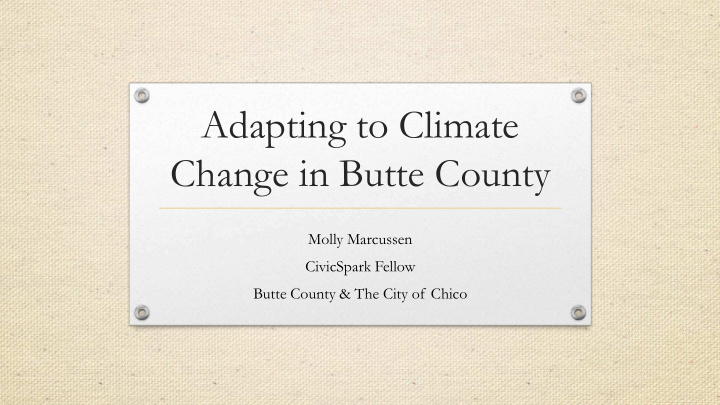



Adapting to Climate Change in Butte County Molly Marcussen CivicSpark Fellow Butte County & The City of Chico
Butte County • Population: 80,533 • Chico Population: 93,383 • Predominantly rural area
Senate Bill 379 • “The General Plan safety element shall be reviewed and updated as necessary to address climate adaptation and resiliency strategies applicable to the city or county.” • A vulnerability assessment that identifies the risks that climate change poses to the local jurisdiction and the geographic areas at risk from climate change impacts, including, but not limited to, an assessment of how climate change may affect the risks • A set of adaptation and resilience goals, policies, and objectives based on the information specified in the vulnerability assessment for the protection of the community.
What is Adaptation?
Geography 506: Community Service Practice in Geography
California Adaptation Planning Guide
Vulnerability Assessment Exposure: what climate change effects will a • community experience? Sensitivity: what aspects of a community (i.e., • function, structures, and populations) will be affected? Potential Impacts: how will climate change affect • the points of sensitivity? Adaptive Capacity : what is currently being done • to address the impacts? Risk and Onset: how likely are the impacts and • how quickly will they occur?
Exposure: What climate change effects will a community experience? Direct Impacts Secondary Impacts • Changes in average temperature • Extreme heat events • Changes in annual precipitation • Increase in frequency of wildfire • Decrease in snowpack
Cal-Adapt
Low Emissions Scenario
High Emissions Scenario
Potential Impacts: How will climate change affect the points of sensitivity? • Increased temperature • Wildfire • Changes in precipitation • Snowpack
Heat Related Health Impacts • Impacts on disadvantage and vulnerable populations • 21% of Butte Counties population is living in poverty • 1,983 people are considered to be homeless • Mental health impacts
Impacts to Agriculture • Changes in growing season • Reduction in “Chilling Hours” • Drought conditions
Wildfires in our Urban Wildland Interface (UWI) • Yankee Hill: Pop. 333, housing 182 • Berry Creek: Pop. 1,424, Housing 983 • Forbestown: Pop. 320, Housing 167 • Concow: Pop. 710, Housing 360 • Forest Ranch: Pop. 1,184, Housing 598 • Cohasset: Pop. 847, Housing 408
Impacts to Biological Resources • Open grasslands, vernal pools, riparian forests, woodlands of all types, and wetlands are all vulnerable to climate change • Temperature rise in streams and creeks unsuitable for Salmon and other aquatic species
Potential Adaptations Extreme Heat • Strategy 1: Incorporate green infrastructure strategies into new and existing infrastructure to mitigate the effects of the UHIE by reducing the area of heat-absorbing paved surfaces and increasing landscaped area with planted vegetation, including shade trees. • Strategy 2: Work with local businesses and institutions to provide a network of “Cool Zone” areas (i.e., cooling centers) for vulnerable residents to rest in air-conditioned environments during high temperature periods and heat wave events. • Strategy 3: Promote the use of solar carports on new and existing surface parking lots to mitigate heat absorption and increase shaded areas for the County’s population. Implementation priority will be given to County owned parking lots to serve as example solar carports. Solar carports would additionally provide GHG-reducing co-benefits by increasing distributed solar generation and, if electric vehicle charging stations are added, improving charging accessibility.
Potential Adaptations Agriculture • Strategy 4: Adaptation of integral system approaches to improve water use efficiency in crops, through more efficient soil and irrigation management • Strategy 5: Switching to low-chill varieties and or exploring new crop production • Strategy 6: Provide educational assistance to famers to adapt/ transition to new crops. Work with Agricultural resource agencies, farm extension offices and research centers in determining future best practices • Need for Localized Agricultural Adaptation Research to Minimize the Risks Due to Increased Temperatures and Extreme Heat Waves
Potential Adaptations Wildfire • Strategy 7: Work with relevant State agencies, including OES and CAL FIRE, to improve coordination for emergency services related wildfire and related events in the County. Consider the development/update of a Community Wildfire Protection Plans to increase community resilience too wildfire. • Strategy 8: Consider new development guidelines for County and City residents and businesses within the UWI, such as incorporating defensible space practices into landscape requirements for neighborhoods at increased risk of wildfire events.
Key Take A ways • Adaptation and mitigation are both essential in fighting the effects of climate change • What we do today does in fact decide tomorrow • For more information and updates to this project please check out the Power Butte Website
Recommend
More recommend